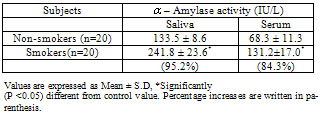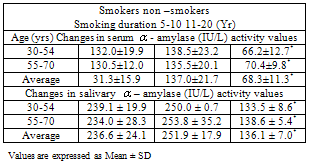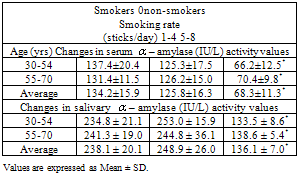-
Paper Information
- Next Paper
- Previous Paper
- Paper Submission
-
Journal Information
- About This Journal
- Editorial Board
- Current Issue
- Archive
- Author Guidelines
- Contact Us
Advances in Life Sciences
p-ISSN: 2163-1387 e-ISSN: 2163-1395
2012; 2(1): 28-30
doi: 10.5923/j.als.20120201.04
Activities of Alpha Amylase in Serum and Saliva of Some Nigerian Cigarette Smokers
Onyesom I. 1, Osioma E. 2, Ifie E. J. 1, Oweh O. T. 1
1Department of Medical Biochemistry, Delta State University, Abraka, Nigeria
2Department of Biochemistry, Faculty of Science, University of Ilorin, Nigeria
Correspondence to: Osioma E. , Department of Biochemistry, Faculty of Science, University of Ilorin, Nigeria.
| Email: |  |
Copyright © 2012 Scientific & Academic Publishing. All Rights Reserved.
This study reports the effect of cigarette smoking on serum and salivary  -amylase activities of some consenting Nigerian male smokers (20) in apparent good health and between 30 to 70 years. Age and sex-matched non-smokers (20) were included as control subjects. Alpha amylase activity was assayed using standard colorimetric method. Results obtained show that the mean α-amylase activity in serum and saliva were significantly higher (P<0.05) in smokers (131.2 ± 17.0 IU/L and 241.8 ± 23.6 IU/L) when compared with non-smokers (68.3 ± 11.3 IU/L and 133.5 ± 8.6 IU/L), and these represent 84.3% and 95.2% increases in serum and saliva values for the smokers relative to the non-smokers. Evidence from this study indicates a measure of pancreatic, salivary and parotid glands’ dysfunction among the cigarette smokers in Nigeria. Measurement of serum and salivary
-amylase activities of some consenting Nigerian male smokers (20) in apparent good health and between 30 to 70 years. Age and sex-matched non-smokers (20) were included as control subjects. Alpha amylase activity was assayed using standard colorimetric method. Results obtained show that the mean α-amylase activity in serum and saliva were significantly higher (P<0.05) in smokers (131.2 ± 17.0 IU/L and 241.8 ± 23.6 IU/L) when compared with non-smokers (68.3 ± 11.3 IU/L and 133.5 ± 8.6 IU/L), and these represent 84.3% and 95.2% increases in serum and saliva values for the smokers relative to the non-smokers. Evidence from this study indicates a measure of pancreatic, salivary and parotid glands’ dysfunction among the cigarette smokers in Nigeria. Measurement of serum and salivary  - amylase activity could be useful in the early detection and diagnosis of pancreatitis and parotitis.
- amylase activity could be useful in the early detection and diagnosis of pancreatitis and parotitis.
Keywords:
 -Amylase, Saliva, Cigarette, Pancreatitis, SmokersThe mean serum
-Amylase, Saliva, Cigarette, Pancreatitis, SmokersThe mean serum  – amylase activity value was higher for the test (smokers) subjects than the control (non-smokers) individuals. This difference was demonstrated to be statistically significant at the 5% probability level using ANOVA. Similarly, the mean
– amylase activity value was higher for the test (smokers) subjects than the control (non-smokers) individuals. This difference was demonstrated to be statistically significant at the 5% probability level using ANOVA. Similarly, the mean  – amylase activity value in the saliva of the control was significantly lower than that of the cigarette smokers.The mean serum
– amylase activity value in the saliva of the control was significantly lower than that of the cigarette smokers.The mean serum  – amylase activity values for cigarette smokers were higher than the non-smokers values and these differences were statistically significant (p<0.05).Subjects’ age did not significantly influence serum
– amylase activity values for cigarette smokers were higher than the non-smokers values and these differences were statistically significant (p<0.05).Subjects’ age did not significantly influence serum  – amylase activity values, but among the smokers, smoking duration affected values significantly (<
– amylase activity values, but among the smokers, smoking duration affected values significantly (<
Cite this paper: Onyesom I. , Osioma E. , Ifie E. J. , Oweh O. T. , "Activities of Alpha Amylase in Serum and Saliva of Some Nigerian Cigarette Smokers", Advances in Life Sciences, Vol. 2 No. 1, 2012, pp. 28-30. doi: 10.5923/j.als.20120201.04.
1. Introduction
- Nicotine, a major component of cigarette could be absorbed in the mouth, and along with other cigarette compounds has been observed to increase the risk of pancreatic cancer[1].Commercially manufactured cigarettes are seemingly simple objects consisting of mainly tobacco blend which may contain over 100 ingredients including tar and flavourants. Tar, a term used to describe the toxic chemicals found in cigarette is present in all cigarettes and tends to increase as the cigarette is burnt down. Tar in cigarette paralyzes the cilia in the lungs and contribute to lung diseases such as ephysema, bronchitis, lung cancer, etc[2].Alpha amylase in animals is a major digestive enzyme with optimum pH of 6.7-7.0. It is secreted by the salivary gland and pancreas, and so present in saliva and serum.
 -amylase is known for its role in the breakdown of large insoluble starch molecules into smaller, soluble molecules. Salivary
-amylase is known for its role in the breakdown of large insoluble starch molecules into smaller, soluble molecules. Salivary  -amylase has been used as a biomarker for stress that does not require a blood draw[3].The effects of cigarette smoking on lung[4] and cardio- vascular[5] functions are well documented, but the changes in serum and salivary
-amylase has been used as a biomarker for stress that does not require a blood draw[3].The effects of cigarette smoking on lung[4] and cardio- vascular[5] functions are well documented, but the changes in serum and salivary  –amylase activities among cigarette smokers have remained scarce in our society. This present study therefore, attempts to report the activities of
–amylase activities among cigarette smokers have remained scarce in our society. This present study therefore, attempts to report the activities of –amylase in serum and saliva of some Nigerian cigarette smokers.
–amylase in serum and saliva of some Nigerian cigarette smokers.2. Materials and Methods
- Subjects: Twenty male cigarette smokers in apparent good health were selected as test subjects from the smoking population. They smoke 2-8 sticks daily, and have been smoking for between 2-20years. Also, twenty individuals who do not smoke or drink alcohol were included as the control subjects. The smokers smoke all brands of cigarette in their locality although some have preference for Benson and Hedges(R). Sample Collection: Blood and saliva samples were collected from the volunteers (20 smokers and 20 non-smokers) in apparent good health. Two milliliters (2ml) of whole blood samples were collected from the subjects using the vene puncture technique and dispensed immediately into a plain, sterile bottle, centrifuged at 1200xg for 5 min at room temperature to get approximately 1.5ml of serum.Saliva samples were collected in sterile containers fresh and analyzed within 6 hours of collection. Data obtained were expressed as Mean ± S.D.Sample Analysis: The activity values of both serum and salivary
 – amylase were determined by the p- nitrophenylheptaoside colorimetric method[6] using freshly reconstituted commercial reagent supplied by Randox Laboratories; Ardmore, UK.Statistics: Student’s‘t-Test’ was used to compare the calculated means of the parameters and the differences between mean values were considered significant at the 5% probability level.
– amylase were determined by the p- nitrophenylheptaoside colorimetric method[6] using freshly reconstituted commercial reagent supplied by Randox Laboratories; Ardmore, UK.Statistics: Student’s‘t-Test’ was used to compare the calculated means of the parameters and the differences between mean values were considered significant at the 5% probability level. 3. Results
- The results obtained are presented on Tables 1, 2 and 3.
|
|
|
 –amylase activity values, but values were seen to be proportionately higher when compared with serum figures.
–amylase activity values, but values were seen to be proportionately higher when compared with serum figures.4. Discussion
- [10], studied the effects of smoking habit on salivary amylase and reported that cigarette smoking does not have any significant influence on salivary amylase activity in the subjects. Also, [11] stated that the degree of amylase activity in the saliva of people who smoke cigarette was not significantly different from that present in the saliva of non-smokers.Individuals with serum amylase level higher than normal could be suffering from renal insufficiency or nephrectomy. Also, high serum amylase activity has been observed in hepatic necrosis and cirrhosis[15] hence the liver is thought to play a role in amylase metabolism. Thus, increase in serum or salivary amylase could be as a result of decreased metabolic clearance of amylase, pancreatitis or parotitis.Parotitis is a salivary disease that is associated with increase in S-type isoamylase. Parotitis is usually caused by trauma, stress or surgery to the salivary gland, radiation to the neck area involving the parotid gland and subsequently causing duct obstruction, or calculi of the salivary duct.
 Abstract
Abstract Reference
Reference Full-Text PDF
Full-Text PDF Full-Text HTML
Full-Text HTML - amylase activity in salvia and serum of cigarette smokers
- amylase activity in salvia and serum of cigarette smokers
 -amylase activity values
-amylase activity values
 – amylase (IU/L) activity values induced by cigarette smoking rates in different age groups
– amylase (IU/L) activity values induced by cigarette smoking rates in different age groups